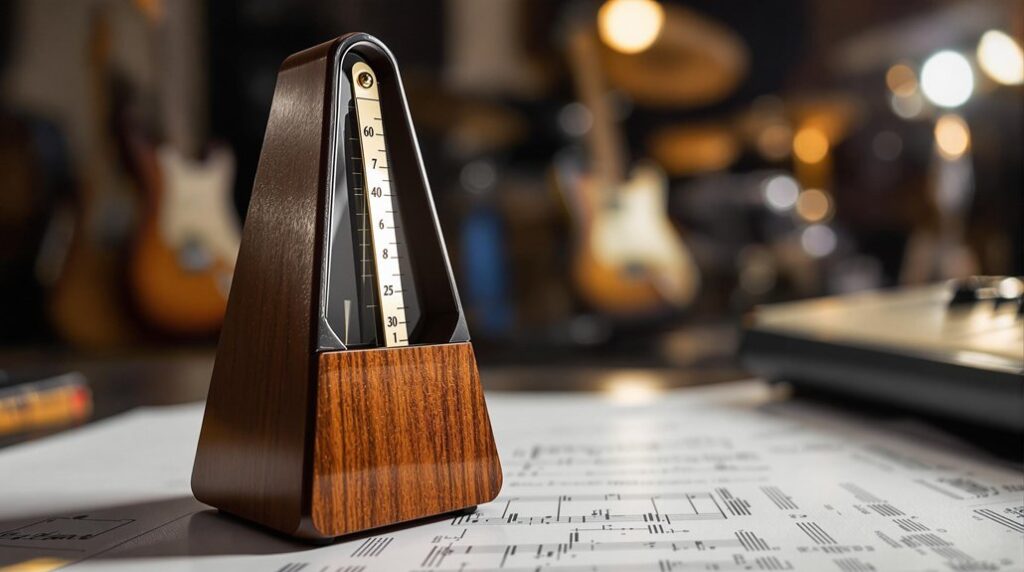Mastering music theory is essential for you as a new producer aiming to craft emotionally impactful tracks. You’ll start with the basics, like notes, scales, and chords, and explore how major and minor scales set different moods. Understanding chord structures, such as diatonic triads and common progressions, will enhance your harmonic creativity. You’ll also learn about melody and harmony, capturing listener attention through memorable motifs. Plus, digital tools and resources can simplify the complex concepts. As you dive deeper into these elements, you’ll find endless possibilities for your sound and production skills. There’s much more to uncover from here.
Key Takeaways
- Understand the fundamentals of notes, scales, and chords to build a strong musical foundation.
- Explore major and minor scales to effectively convey different emotional tones in your music.
- Incorporate chord progressions, such as I-IV-V, to create emotionally resonant and satisfying resolutions.
- Utilize resources like MIDI libraries and chord progression generators to inspire your creativity and enhance your productions.
- Engage with the music community for collaboration, learning, and continuous skill development in music theory.
Foundations of Music Theory
Understanding the foundations of music theory is essential for any aspiring producer. Mastering the music theory fundamentals—like notes, scales, and chords—provides a solid foundation for your musical creations.
You’ll find that major and minor scales influence the emotional depth of your pieces; major scales often evoke happiness, while minor scales convey complexity. Chords, derived from these scales, create harmony and context, enhancing your melodies and the overall emotional narrative.
By grasping how melody and harmony interact, you’ll gain the tools to craft engaging compositions. Embrace music theory as a lifelong journey, allowing for continuous exploration and experimentation. Understanding the emotional impact of minor scales will help you convey diverse sentiments in your music.
This knowledge won’t only refine your skills but also foster collaboration with other musicians, enriching your artistic vision.
Scales and Modes
Scales and modes are the building blocks of musical expression, offering a palette of sounds for producers to explore.
Scales, such as major and minor, set the emotional tone of your music—major scales often uplift listeners, while minor scales evoke a somber mood.
Modes, derived from the major scale, include Ionian, Dorian, and Phrygian, each adding to melodic complexity.
The pentatonic scale, with its five notes, is versatile and commonly found in catchy hooks, especially in hip-hop.
Understanding how these scales relate to chord progressions is key to crafting music that elicits emotional responses.
Additionally, mastering advanced scales like the chromatic scale enhances your ability to create unique tonalities and enrich your compositions, deepening your grasp of music theory.
Moreover, a solid grasp of time signatures is essential for effectively communicating rhythmic ideas within your music.
Chord Structures
After exploring scales and modes, it’s time to focus on chord structures, which are fundamental for shaping your music’s harmonic foundation.
Chords, formed by combining three or more notes, include the basic major and minor chords that evoke different emotions. Understanding diatonic triads is vital; they’re built on each scale degree and analyzed using Roman numeral analysis (I, ii, iii, IV, V, vi, vii°).
Advanced chord types like seventh and ninth chords enrich your sound, especially in jazz and R&B. Familiar chord progressions, such as the I-IV-V progression, create satisfying resolutions.
Mastering chord inversions and voice leading techniques allows for smoother shifts, enhancing your musical progressions and overall composition quality. Additionally, the Circle of Fifths is a valuable tool for exploring chord relationships and facilitating seamless transitions between keys.
Melody and Harmony
When you craft memorable melodies, you capture your listeners’ attention and draw them into your music. To enhance the depth of your harmony, consider how chords can support and enrich your melodic lines. Understanding chord progressions can guide your emotional storytelling and create a captivating sonic narrative.
Crafting Memorable Melodies
Crafting memorable melodies is essential for any music producer looking to captivate their audience. Start by understanding intervals, as they define the distance between notes and shape emotional impact.
Incorporating motifs—short, recurring musical ideas—creates cohesion and boosts listener engagement. Balance tension and resolution using techniques like suspensions, which enhance emotional depth.
Don’t forget to add passing notes; they can introduce movement and fluidity, making your melodies more dynamic. Experimenting with rhythmic patterns offers unique expressions, greatly affecting the overall feel of your track.
Enhancing Harmony Depth
Melodies alone can captivate listeners, but enhancing harmony depth takes your music to another level. By incorporating rich chords like triads and seventh chords, you create emotional depth. Mastering voice leading guarantees smooth shifts between chords, enhancing your piece’s flow.
Utilize counterpoint to intertwine independent melodic lines, adding complexity to your harmonic structures. Advanced chord progressions, such as ii-V-I, can evoke specific emotional responses, elevating engagement. Experimenting with harmonic textures through layering instruments and adding extensions like ninths and elevenths contributes to a fuller sound.
| Technique | Description |
|---|---|
| Voice Leading | Smooth shifts between chords |
| Counterpoint | Intertwining independent melodies |
| Advanced Progressions | Evoking emotional responses |
| Harmonic Textures | Layering instruments for fullness |
| Extensions | Adding depth with ninths and elevenths |
Practical Applications
Understanding chord progressions like I-IV-V is key to creating tracks that resonate emotionally with listeners.
You can also enhance your melodies by experimenting with different scales, allowing for fresh and enchanting sounds. Additionally, mastering rhythm and beat mastery is crucial for conveying emotion and intention in your productions.
Utilizing Chord Progressions
When you explore chord progressions, you’ll find they serve as the backbone of your music, shaping its emotional terrain and engaging listeners across genres.
Understanding diatonic triads in both major and minor scales lets you craft harmonically rich progressions that evoke specific moods. Here are some practical applications to enhance your tracks:
- Use common progressions like I-IV-V or ii-V-I for satisfying resolutions.
- Incorporate advanced chords, such as 7ths and 9ths, to enrich harmonic texture.
- Familiarize yourself with the circle of fifths for smooth key shifts.
- Experiment with specific chord choices in genres like Liquid DnB and Hip Hop.
- Consider the emotional impact of your progressions to enhance the listener experience.
Effective Melody Construction
Crafting a memorable melody requires a thoughtful approach to scales, rhythms, and motifs that resonate with listeners. Start by utilizing major and minor scales to set the emotional tone; major often conveys happiness while minor evokes sadness.
Incorporate rhythmic variation and motifs, like recurring phrases, to enhance memorability and engagement. Understanding intervals is essential as they define the distance between musical notes, shaping your melody’s contour.
Techniques such as tension and release through suspensions and resolutions can deepen emotional impact, keeping listeners captivated. In your DAW, experiment with different note patterns and layer melodies to create richer soundscapes.
Digital Tools and Resources
As you immerse yourself in music production, utilizing digital tools and resources can greatly improve your creative process. Tools like chord progression generators and MIDI pattern libraries help you visualize harmonic structures and experiment with compositions. Advanced synthesis software and sample packs enhance your sound design capabilities, streamlining idea prototyping.
Consider these resources:
- MIDI pattern libraries for diverse rhythmic ideas
- Chord progression generators to inspire harmony
- Interactive lessons on platforms like Melodics
- Online tutorials that simplify complex music theory
- Community engagement in peer-to-peer forums
These resources make learning accessible for new producers, encouraging collaboration and continuous growth in your music production journey. Additionally, exploring advanced techniques in sound design can elevate your productions to new heights.
Embrace these tools, and watch your skills flourish!
Frequently Asked Questions
How Long Does It Take to Learn Music Theory?
It really depends on your learning pace. With practical application, using theory resources like online courses and music theory apps, you can achieve milestones quickly. Establishing practice routines and engaging in comparative studies can enhance your understanding greatly.
Can I Write Music Without Knowing Music Theory?
You can absolutely write music without knowing music theory. Trust your writing intuition, explore sound, create melodies, and experiment with genres. Your emotional connection and personal style can shine through improvisational skills and music software.
What Are the Common Mistakes Beginners Make?
Beginners often fall into common misconceptions like ignoring scales, neglecting rhythm, or misunderstanding chords. They might skip ear training, overcomplicate progressions, and avoid collaboration, relying solely on software and disregarding valuable feedback, leading to inconsistent practice.
How Do I Stay Motivated While Learning?
To stay motivated while learning, set clear goals, create practice routines, and track your progress. Seek inspiration from various sources, use accountability partners, take creative breaks, and engage with community support and learning resources for encouragement.
Are There Specific Genres That Require Different Theory?
Yes, different genres use unique genre-specific techniques. You’ll find variations in rhythm patterns, harmonic structures, melodic compositions, chord progressions, arrangement styles, instrumentation choices, cultural influences, lyrical themes, and production methods that define each style.
Conclusion
Now that you’ve explored the foundations of music theory, you’re ready to apply these concepts to your production journey. Understanding scales, chords, melody, and harmony will enhance your creativity and confidence. Don’t forget to leverage digital tools to streamline your workflow and experiment with your sound. Keep practicing and pushing boundaries—mastering music theory is a continuous process that will ultimately uplift your productions. Get out there, create, and let your unique musical voice shine!




